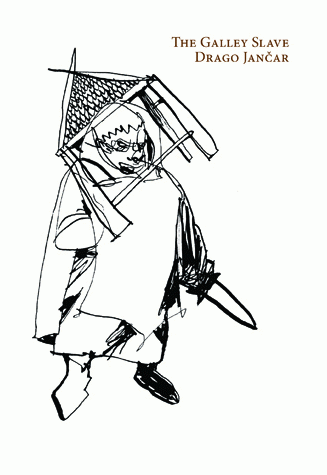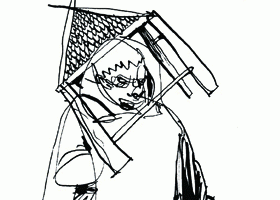 Slovenian writer Drago Jančar published The Galley Slave in 1978, but it doesn’t bear too many signifiers of that particular time, at least to Western eyes. Its setting is firmly premodern. Even though the novel is set in the identifiable 17th century, plague and witch-trials are the two most frequent events. This is not the civilized world.
Slovenian writer Drago Jančar published The Galley Slave in 1978, but it doesn’t bear too many signifiers of that particular time, at least to Western eyes. Its setting is firmly premodern. Even though the novel is set in the identifiable 17th century, plague and witch-trials are the two most frequent events. This is not the civilized world.
Emerging from a long trek through a swamp, Johan Ot arrives in a small town in Central Europe, around the Adriatic. Protestantism burgeons, Leopold I is Holy Roman Emperor, and the plague is visiting town after town, so I suspect we are in 1679, year of the Vienna Plague.
Everyone is scared, even the Emperor. No one understands a damn thing. The Scientific Revolution may have happened, but the upper classes are absent from this book; this is about the countryside, and so it feels medieval. No one knows who to blame and no one knows what causes anything. Is it God? The Devil? Witches?
The nightmarish events and even the protagonist’s name, Johan Ot, might recall Kafka, but the resemblance is only superficial. In Kafka there is a sharp delineation between the protagonist and the other characters and setting. Josef K., Gregor Samsa, and the rest are devoid of true allies, and they are always singular characters distinct from anyone else in the world.
In The Galley Slave, Johan’s fate is not signaled to be anything especially different from that of those around him, other than by chance or misfortune. Others can be friendly or hostile, but they hold no secrets. Some of them have authority and control, though–people do not differ by levels of knowledge, only by degrees of power. At times, Johan does begin to suspect he might be different, a thought that Kafka’s characters resolutely avoid. The chaotic tumble of events, which sends him all around the Adriatic coast and eventually toward Venice, is closer to Kleist or Leskov.
Johan has some medical skills; he takes up lodgings in the town and is comfortable. Jančar tends to announce the forthcoming plot points before they occur, lending a didactic and premodern slant to the narrative. So when there is much talk of witch trials and the gathering of evidence, we know Johan will be arrested and tried long before it happens in a flash, after a dizzy summary of pagan rituals that seem half-dreamed by him.
Though the process for the trial is set out in detail, again hinting at Kafka, the condemnation is quick. (Carlo Ginzburg’s The Night Battles depicts how such trials went.) Yet Johan escapes his death by being taken in by a revolutionary millennial religious brotherhood (leftovers of the Templars?), seeking to overthrow church and state both. From them he sees “the true face of the world”:
Fire and blood and chaos were the order of the day. The cruel, bloodthirsty Turk was still skewering innocent Christian children on his pike before their parents’ eyes. He had been beaten back a hundred times, but still he wouldn’t relent. Rebellious peasants were being condemned to death and the gallesy. The nobles were undermining the Emperor’s and the Church’s authority with their plots and feuds. The Church was perpetrating the worst sacrileges. Barely had it managed to subdue Luther’s false prophets than it was once again overtaken by greed, sin, and viciousness….
But the old brotherhood was still alive. It was corroding this world of darkness at its roots. It’s true it had been involved in the uprisings. It’s true it had been a part of conspiracies. For aren’t all means permitted when one is destroying a world built on chaos and error? (84)
This truth fades. The brotherhood sends him on missions to spread the secret gospel (it might be Protestant, but it feels millennial), but he loses interest and falls in with a reasonably affable group of merchants, settling down and sleeping with Dorotea, the wife of successful merchant Locatelli. The government and the revolutionaries have not forgotten him, of course.
Further events ensue, including an anomalous episode between Dorotea and Emperor Leopold, which seems to have wandered in from another book. Other frequent but less jarring shifts in tone occur as well, making it harder to figure out just who Johan Ot is, or just who anyone is. Beneath the chaos, this is the center of the book, and whatever identity Johan claims for himself is slowly removed as he is drawn toward his eventual fate as a Venetian galley slave.
The question of identity is paramount. Though this is hardly a totalitarian regime, Johan is claimed by various groups over the course of the book, and his inability to find any enduring place for himself.
What did Johan Ot want, where did he come from and where was he going and what, in fact, was he doing in the middle of this moment that seemed forever to turn back on itself? Surrounded by dangers and pleasures that, to tell the truth, had absolutely nothing to do with him? What brilliant notion did Adam have inside him that his eye burned bright and his mind spun and spun, and all he craved was action? And Ot’s covenant–hadn’t he once been a member of a group that also wanted to create and order things in this world? He had? A horrid shudder went up his spine. He had? And a sharp realization shot through him, one that had already pushed him out into the world so many times before: get going. Bad things are brewing here. Blades are being sharpened here, and ropes are being braided for necks. Get going. Away from this place. Here he would only rot in some tower of justice again, some joker would put on the thumbscrews and he’d be paraded through the streets on a cart like some exotic beast. That morning by the river he felt the whole of the chaos of the universe within him, and it shifted and jostled and collided inside him, sharpening into a single, clear thought: get going. (171)
Each time he leaves he loses himself. Hints of his life before the start of the book are given, but only faintly. The use of the premodern setting is extremely unsettling: the moorings obtained in urban life to assert one’s self, one’s thoughts, and one’s sanity simply don’t exist. Superstitions cannot be so easily disposed of, when a coherent truth is not available. Johan tries to trust his senses and his instincts, but they cannot stand up to the assault of incoherence.
Here Kleist looms large, but Kleist remains at the level of event and surface to portray the cosmos more than the person. Jančar’s delicate engagement with Johan’s psychology creates a frightening evocation of ego-collapse, the likes of which readers are fortunate not to know today. Whether it is accurate is difficult to tell: the premodern pre-urban mentality seems to resist capture in words. (That strange Leopold/Dorotea episode causes the book to lose focus for a bit.) But with those psychological touches, Jančar gets closer to its absolute foreignness than many, and the last third paints Johan’s final release of his self with an austere and punishing gracefulness.
It’s best summarized when Johan is sick, lying on a hillside watching a procession of inspired, self-flagellating pilgrims with torches. A toothless vagrant tends to him and tells him:
“You’re bad off,” he said. “You’ve seen everything but you’ve understood nothing. Everyone is getting slaughtered and flattened in these times of ours. Other people know why. You haven’t passed any of your tests very well.” (245)
To which Johan replies, in a virtually anachronistic moment of clarity:
“I see just one thing–this sorry country and this terrible mess. This mental illness that’s crossing through the land and drenching it through and through–the land, the air, the people. I said that once somewhere. They tried to butcher me for that. So I’ll say it again: spiritual anguish is being forged into human substance. That’s why all of this has to collapse, disintegrate, and rot. Along with me.” (247)

Leave a Reply